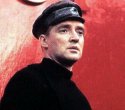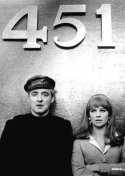|
Fahrenheit 451
From the opening scene of Fahrenheit 451, you know this is a film unlike any other. The camera zooms in on rooftop television antennae as a narrator reads the credits aloud, rather than showing them on the screen. This is only fitting for a story set in a future where books are banned and people treat the television as if it were a family member.
Francoise Truffaut does a masterful job of bringing Ray Bradbury's classic story, written in 1960, to life. The premise is that with the triumph of television, any independent thought or act becomes subversive. To read is the ultimate antisocial act, and books are banned under the pretext that they make people unhappy or dissatisfied with their lives. Fireman now no longer put out fires. Instead their duty is to expose people who read, confiscate their books and burn them. When they discover such a criminal, they place the contraband on a bier and, donning fireproof robes as vestments, they burn the sacrifice with a flame-thrower.
The film's protagonist is a fireman named "Montag", played by Oskar Werner. The great Cyril Cusack is his fire chief. Julie Christie does double duty as Montag's narcotized wife and as a rebellious schoolteacher. In Truffaut's deft hands, the cast delivers a subtly affecting ensemble performance. Peter Weir was responsible for the stunning cinematography.


The "future", as Truffaut imagined it in 1966, looks remarkably like the former Eastern Germany looks today. Row upon row of bleak apartment blocks fill the urban landscape. Prefabricated houses squat incongruously in suburban developments. The art direction is brilliantly conceived. Eschewing flashy "futuristic" gimmicks, it instead presents a more believable future by bringing back icons of the past. Firemen wear minimalist black uniforms with helmets reminiscent of those the Trojans wore. The fire truck is a marvelous relic from the 1940s, which the firemen ride standing up, as though it were a chariot. Their mascot is a stylized salamander, a creature once believed to be born of fire. An amazing suspension monorail provides public transport. At each stop, a long stairway descends, as if passengers were disembarking from a cloud. In general, the art direction is more imaginative and original than any post-war "science fiction" film I can think of (including Blade Runner, some fifteen years more recent).
The "message" of the film, no doubt dear to Bradbury's writer's soul, is beyond mere statements against conformity, the pernicious effects of television or a totalitarian state. It suggests that books, especially great books, have spaces between their words that allow us to enter them and find ourselves, and perhaps each other.


|

